NEM – A primer on European Model Railroad Standards
Published: 2018-06-14 - By: bobfallier
Last updated on: 2021-08-13
Last updated on: 2021-08-13
visibility: Public
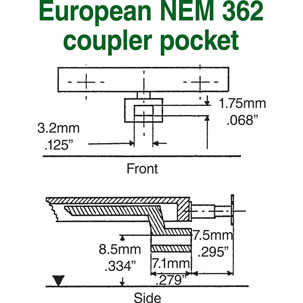
NEM – A primer on European Model Railroad Standards
NEM “Norms of European Model Railway” or “Normal European Modelling” (in the UK), was essentially established by MOROP “Organization of Model Railroaders and Railway Friends Europe” in pretty much the same manner that the NMRA has set standards for model railroading in North America. While many of the standards set in NEM are similar or identical to NMRA standards, there are some differences specific to “continental” modeling scales. MOROP consist today of 21 national organizations with more than 30,000 members in 16 European countries.“The NEM standards are defined and maintained by the Technical Commission of the MOROP in collaboration with model railroad manufacturers.” (Wikipedia)
The NEM standards define model railroad scales and gauge, and guide manufacturers in producing components that are compatible with each other. The NEM standards also define areas such as turnout radii, grades, rail and wheel profiles, DCC, and many others. Many of the standards are scale specific. Wheel standards for example suggest a deeper flange for smaller scales for more reliable operation. While there are many differences between NEM and NMRA, an area where the two organizations have worked closely together is for the design and development of DCC.
There are many resources that can delineate or identify the distinctions between NMRA and NEM, but the intent of this article is to highlight NEM standards or practices that are common to European and American (US and Canada) model railroading. What led me to write this is my own desire to find a way to interchange what is called the “Rapido” N scale coupler with something compatible with more typical knuckle couplers.
Micro-Trains has for many years had conversion kits available, sometimes replacing only the coupler and if couplers are truck mounted, then replacing the entire truck/coupler assembly. It is not the intent of this article to document or detail the Micro-Trains products as there are people infinitely more qualified to do that than me.
For years Fleischmann has offered a “Profi” coupler conversion for many of their releases which allows a much closer and prototypical appearance between cars, but these are not knuckle couplers and only work with themselves. Kato and some of the other Japanese manufacturers also have non-interchangeable couplers which work very well, with like couplers only.
When I purchased an Arnold Rapido passenger car set (Blauer Enzian 5 car passenger set #0174) , and later a Minitrix ICE-3 set, I noted that the couplers were semi-permanent in appearance, something like a “draw bar”, which allowed very close coupling between cars. My concern at the time was two-fold: could I replace them if I broke one, and could I replace them with something else?
Noting in the instruction booklets that the couplers and pockets were “NEM” I began to research NEM standards and found #355 defined the height, size, & position of the coupler pocket relative to the railhead and also mechanical drawings for the coupler interface itself, which is little more than a flat “tab” that snaps into the pocket on mating cars. NEM 355 also defines the angle at which the coupler may move vertically. Since the “tab” snaps firmly into the pocket on each car, it is highly unlikely that they will uncouple when going over uneven track, such as transitions in elevation or uneven track junctions, or as may occur between NTrak modules when they are not properly aligned.
The answer to replacement is: yes. While the NEM 355 tab is very convenient and reliable, it also has a downside: uncoupling for the purpose of storing cars. My concern here was that repeated deliberate uncoupling may result in accidental damage or weakening of the coupling box or breakage of the small pins on either side of the tab that actually form the physical connection between tab and box. DAPOL to the rescue. Further research into NEM couplers resulted in finding DAPOL, a UK manufacturer who makes several types of knuckle couplers that conform to the NEM 355 coupler pocket.
Illustrations below: Fixed bar coupler to fit NEM 355 pockets on both ends, knuckle (Dapol), & Rapido (Graham Farish) with NEM 355 tabs.
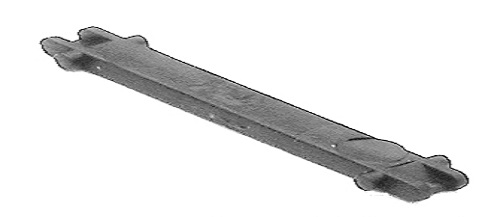

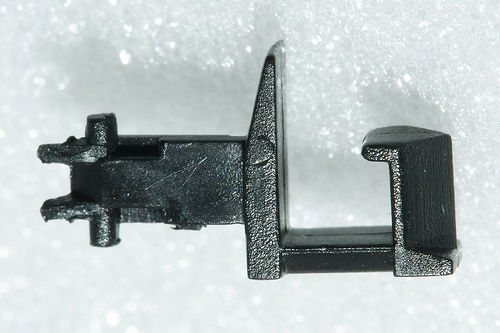
Both the Fixed Bar and Magnetic couplers are available in different lengths, much like many Micro-Trains coupler kits. Dapol couplers are available in pairs or sets, magnetic or non-magnetic. Dapol 2A-000-011 Magnetic Arm (5 Pairs) Short (shown below). They are compatible with Micro-Trains or similar couplers, but check the height to be sure.
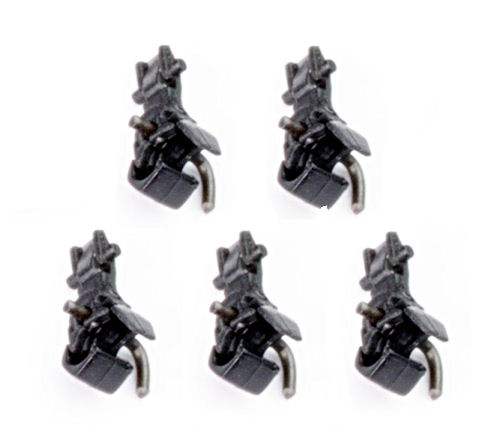
A non-NEM coupler is available from Kato. The Type A has a variation of the T-shank common to standard Rapido couplers, but the mating faces are interesting. They appear to have a Scharfenberg coupler (photo below on DB ICE-3) with a small Rapido style hook below. When cars are coupled the hook is barely noticeable. The face of the Scharfenberg coupler shown, has a protruding cone and a matching cup. When pushed together internal “hoops” extend between mating couplers and are mechanically “captured”. A number of American light rail and commuter lines use this type of coupler. They are also used on the TGV and other high-speed rail systems in Europe and Japan. Unlike many other couplers, is not dependent on heavy latches to stay locked. More detailed information can be found on Wikipedia.
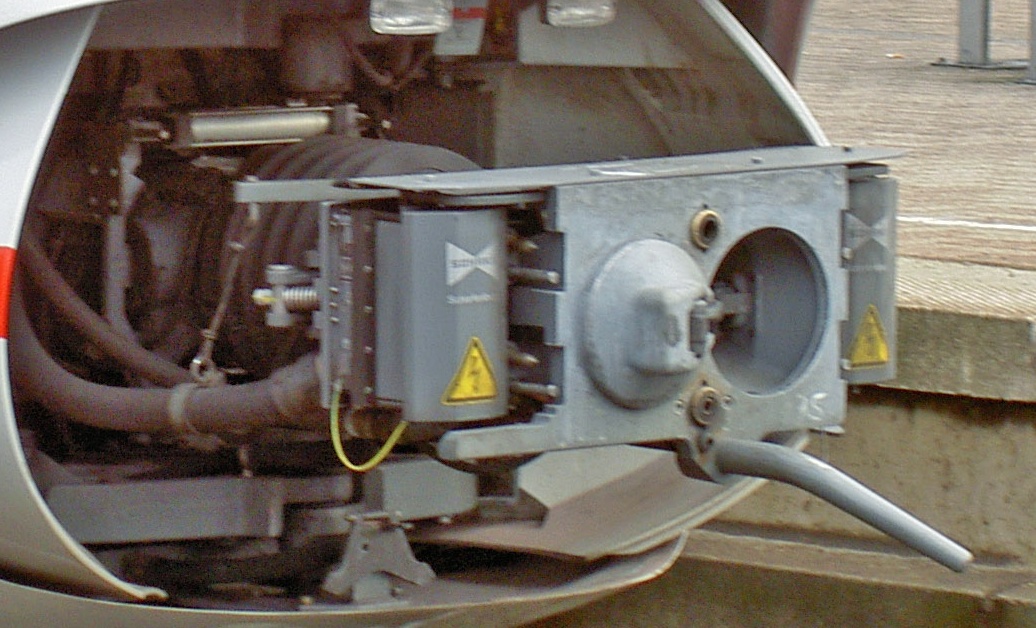
Below a set of 20 Kato Type A couplers, black, with “hoses”. These are an easy snap-together assembly.
.jpg
)
The Type B coupler below is not compatible with either NEM 355 or the T-Shank box, but the image below does show the Scharfenberg housing over the small Rapido hook below. The Type A would look like these, but with a T-Shank mounting.
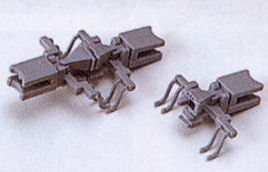
The Pin & Socket on the Scharfenberg portion maintains alignment while the small hook keeps the couplers together and is quite reliable. Unfortunately Kato has not produced a version of this coupler with a 355 mounting tab.
Comparison photos – Here you can see the nearly scale size of the Kato/Scharfenberg (Type A) next to a NEM 355 Rapido and knuckle coupler. For clarity, the Kato Type A is shown without the upper part of the coupler assembly.
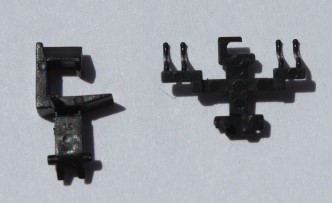
Below top : Very close coupling between cars is possible with the Type A. Shown with Rapido & magnetic knuckle. Below Right: Long & short “bar”, non-operating knuckle, magnetic knuckle.
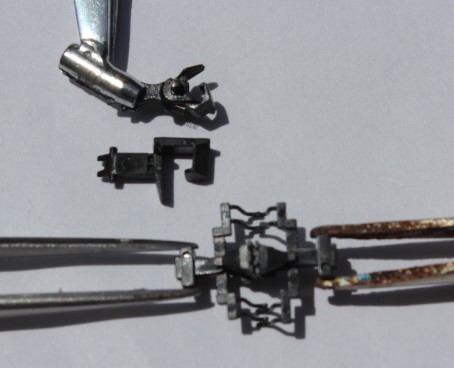
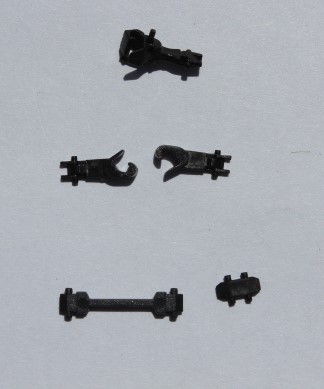
A page from the MOROP website…
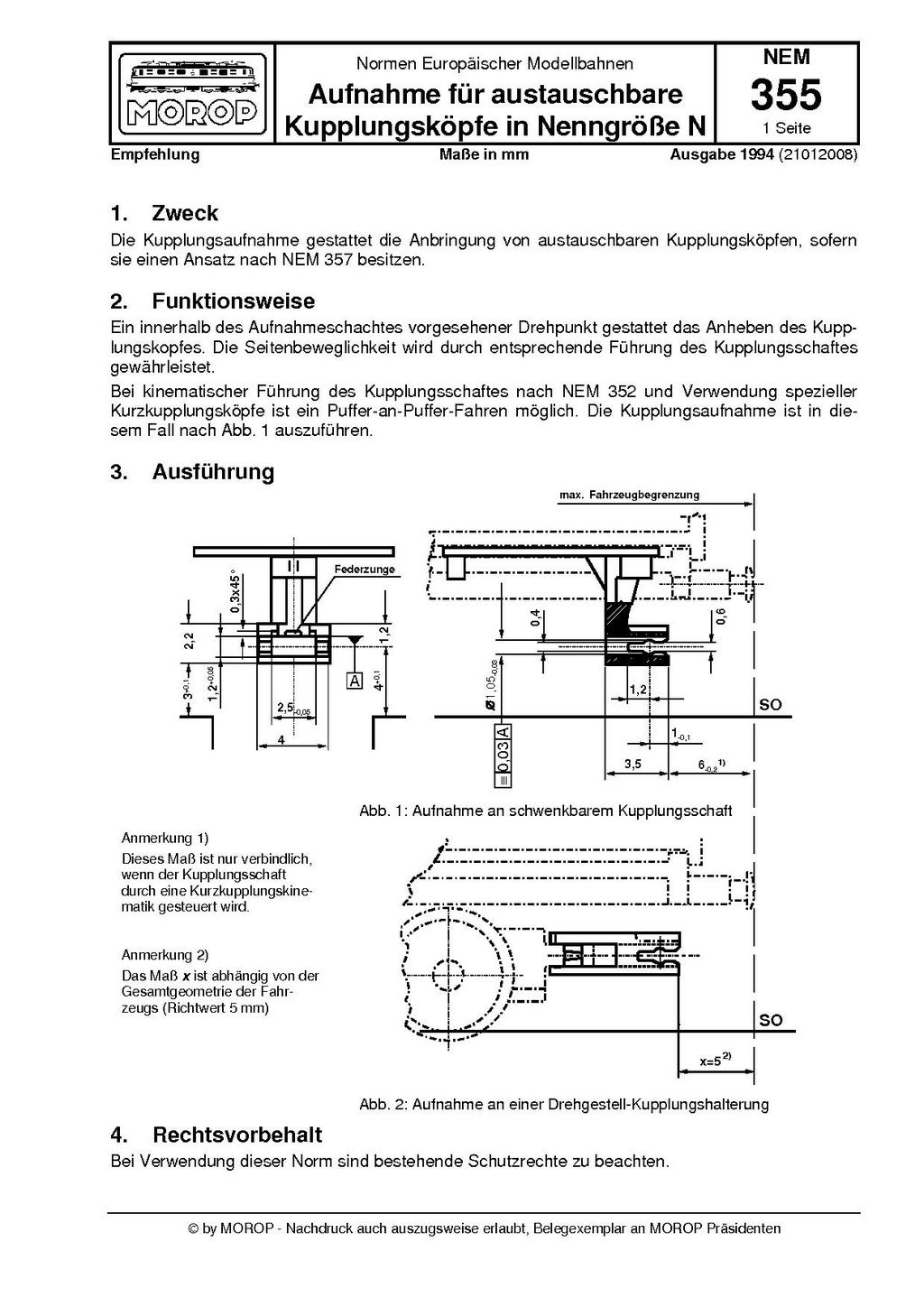
NEM 356 & 357 clearly define the characteristics and dimensions of the Rapido coupler. Below screen capture from NEM 357.
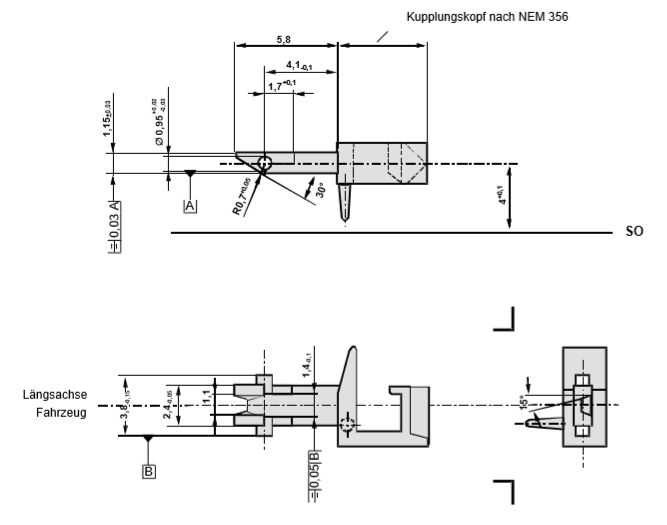
Partial NEM 355 coupler comparison
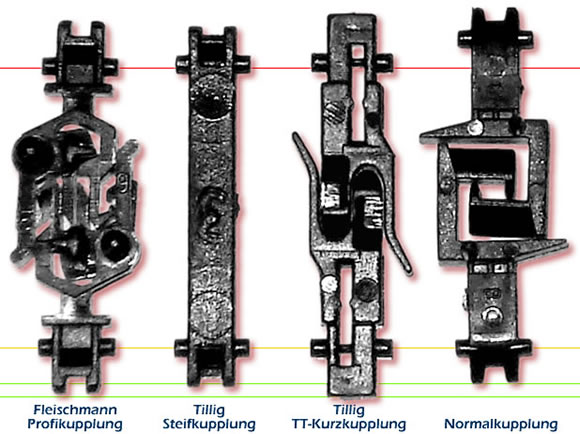
Thus far I’ve focused on NEM couplers, but NEM and NMRA have many commonalities. Since TroveStar is primarily an N scale data resource, I’ll focus on N standards. For European models, NEM 303 defines the size and location of the “Puffers” (spring loaded bumpers) on the ends of cars, 357 is specific to Rapido couplers with NEM 355 attachment, and 359 defines couplers for TT scale. Like NMRA, the list goes on. Another NEM standard that we, as North American modelers often see is NEM 651, which I’ll come back to.
We are all familiar with the variations of gauge and scale, where track of one scale may be used in a large scale as a “narrow gauge” track. HOn3 for example can make use of N scale track as a “3-foot gauge”, and in like manner N scale can use Z scale track for Nn3 narrow gauge. While the tie spacing, or size may not be prototypical for narrow gauge, their use is convenient for those who don’t want to hand-lay their own narrow-gauge track or find it difficult to locate the correct pre-made track.
Again, scale and gauge are sometimes used interchangeably, though not necessarily correctly.
Without going into detail, it can clearly be said that some of the NEM standards for the UK may vary substantially from the rest of the European market. N scale in the UK is 1:148 and in Japan N scale may be produced as 1:150. However, it is notable that Japanese products intended for the American market are typically 1:160 that we consider the standard for N scale. European N scale also conforms to 1:160, or more appropriately we conform to European N scale, which was first popularized by Arnold Rapido in Western Germany.
Model railway scales and gauges are standardized in NEM 010, which covers several gauges for each scale. Narrow gauges are indicated by an additional letter added after the base scale as follows: (Wikipedia)
- no letter = standard gauge (prototype: 1,250–1,700 mm or 49.2–66.9 in)
- m = metre gauge (prototype: 850–1,250 mm or 33.5–49.2 in)
- e = narrow gauge (prototype: 650–850 mm or 25.6–33.5 in)
- i = industrial (prototype: 400–650 mm or 15.7–25.6 in)
- p = park railway (prototype: 300–400 mm or 11.8–15.7 in)
Below is a chart listing typical model railroad scales, but further definitions can be found for “fine scale” or “proto scale” as opposed to the standards shown.
| |
|
|
|
||||
|---|---|---|---|---|---|---|---|
| Z | 1:220 | 6.5mm (0.256 in) | 4.5mm | - | - | - | Based on Märklin factory standards |
| N | 1:160 | 9mm (0.354 in) | 6.5mm | 4.5mm | - | - | Based on Arnold factory standards |
| TT | 1:120 | 12mm (0.472 in) | 9mm | 6.5mm | 4.5mm | - | -- |
| HO | 1:87 | 16.5mm (0.65 in) | 12mm | 9mm | 6.5mm | 4.5mm | "Half O" |
| S | 1:64 | 22.5mm (0.886 in) | 16.5mm | 12mm | 9mm | 6.5mm | -- |
| O | 1:45 | 32mm (1.26 in) | 22.5mm | 16.5mm | 12mm | 9mm | -- |
| 1 | 1:32 | 45mm (1.772 in) | 32mm | 22.5mm | 16.5mm | 12mm | -- |
| II | 1:22.5 | 64mm (2.5in) | 45mm | 32mm | 22.5mm | 16.5mm | Known as Guage 3 in UK |
| III | 1:16 | 89mm (3.5in) | 63.5mm | 45mm | 32mm | 22.5mm | -- |
| V | 1:11 | 127mm (5in) | 89mm | 63.5mm | 45mm | 32mm | -- |
| VII | 1:8 | 184mm (7.25in) | 127mm | 89mm | 63.5mm | 45mm | -- |
| X | 1:5.5 | 260mm (10.25in) | 184mm | 127mm | 89mm | 63.5mm | -- |
As mentioned above, the North American & European standard for N scale is based on the original Arnold Rapido standard, but differs from Japanese and British N scale. Both NMRA and NEM also define the specifics for Fine and Proto scale products and proportions, which I will not address in this article. Fortunately, the standard scales are based on a 1:1 rail spacing of 4’ 8 ½”, although the conversions from 1:1 to several of the smaller scales are not exactly divisible, so some leeway has been taken here and there.
NEM 651:
What makes a decoder work, what the connections and colors are for wiring, and the functions of DCC decoders is the subject of many extensive articles and videos to be found elsewhere on-line and in various publications.
Both the NMRA and NEM as adopted various standards for the electrical and mechanical interface between DCC decoders and a locomotives electrical system. Using standardized plugs and sockets, the installation of DCC decoders has been greatly simplified for the average model railroader in very many cases. We are all aware that there are decoders that are made to fit a specific manufacturers chassis/frame and others that are more “universal”.
NEM 651, the small 6-pin decoder that many of us have used is only one of several standards used both by European and American market products. There are also a NEM 652 (8 pin) and NEM 654 (4 pin) standards which are common in many HO and O scale locomotives.
Note that some 651 decoders may perform better with European models, such as those from Minitrix with precision Faulhaber or Swiss made Maxon motors. The Zimo brand MX651N seems to have been designed almost specifically for these motors and the level of control, especially for steam locomotives is excellent. You will also find that replacing a dummy plug with a 651 decoder is about as easy as it gets. However, be aware that you may need to add a slight bend to the pins in order to maintain a solid contact with the interface housing. Below is a comparison.
Pin locations and comparative sizes


Pin Assignments and Wire Colors

Other NEM decoder definitions:
NEM 660: (Wikipedia)
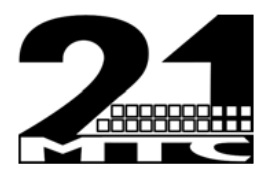
The 21 pin MTC interface is a standard adopted by both the NMRA and NEM 660. Its name comes from 21 pin Marklin/Trix Connector, developed by Marklin and ESU . It is often found in locomotives with OEM decoders from ESU.
This interface is always a direct-connect type where there is no wiring harness. The decoder plugs directly on to the pin header mounted on the locomotive chassis. The MTC 21 has been discouraged by the NMRA since 2010 and replaced by the NEXT 18 interface.
NEM 662: Sticking with N scale related standards, the NEXT 18 interface. (excerpt from Wikipedia)
MOROP appears to have created the Next18 standard for extremely tight applications. In addition to specifying the electrical interface and connectors, the NEM 662 standard also mandates the maximum physical size of decoders. A fully compliant Next18 decoder is no larger than 15mm x 9.5mm - one would fit on a US dime; a Next18S decoder is no larger than 25mm x 10.5mm - it would fit on a US quarter.
There are two variants: Next18 and Next18S. Next18 supports motor control, front and rear headlights, and 6 auxiliary output functions A Next18S decoder adds sound by sacrificing two auxiliary function outputs for two speaker connections.
The interface specifies an extremely small 18-pin "encapsulated" connector. The entire connector is only 8mm long and 5mm wide. Because of their small size, connector pins are only rated for 500 milliamps, so some connections are allocated two pins. The result being that although there are 18 pins, some are redundant, and the 18 pins provide only 12 discrete connections. A feature of the interface is "smokeless symmetry". Pins are assigned in a somewhat symmetric fashion, such that if installed backward, no harm is done to either the locomotive or the decoder; it will not function properly, but nothing will be "smoked".
Author’s note: a word of caution. Not all NEXT18 decoders are the same. I purchased a Kato/HobbyTrain E184 engine with excellent detail and sound from Germany. It came with a Doehler & Haas NEXT 18S decoder installed. In a long series of emails and two returns to Germany, it was finally determined that the D&H decoder would not work with NCE, Digitrax, and any other DCC system which do not provide a minimal 17 volts at the wheel pick-ups. The D&H was finally replaced with an ESU micro decoder and the final product is excellent. But this was a long and painful experience.
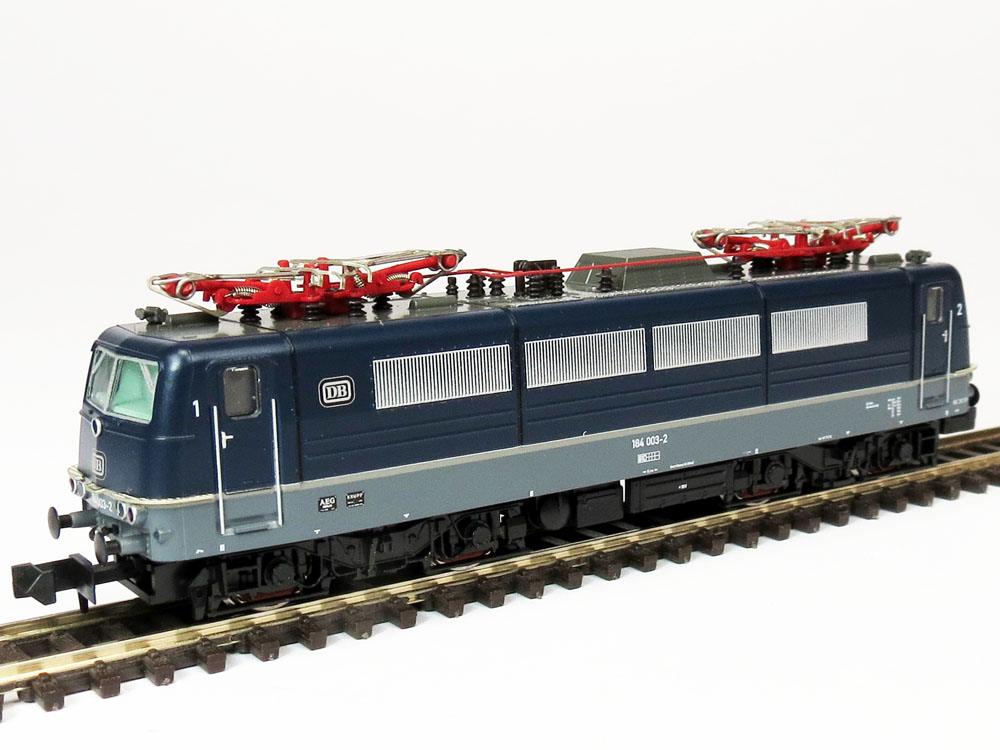

A recent purchase of a Minitrix 4-6-2 BR 18.4 marked for digital on the box led to some investigation. At the time of purchase, it was noted that 4-digit Minitrix boxes did not have an interface socket. Checking several engines at home with clearly older packaging, I noted some may in fact have a NEM 651 dummy plug installed. The point is, even though the box may not indicate DCC ready, it may very well be a quick plug-and-play conversion. Check the included slip-sheet or exploded diagram before you purchase. You may have a pleasant surprise. Any brand 651 decoder should work, but I would recommend a Zimo MX621N with a 6-pin plug (available from Streamlined Backshop – SBS4DCC.com and others). Check the TroveStar database for your specific engine.
Worth noting is that some Minitrix engines may come with a proprietary decoder interface which is not easily replaced with a standard format decoder.
All three of these examples have a NEM 651 DCC socket, but it is not obvious from the packaging. One shows a 6-pin NEM icon, the other two give no indication at all. #12687 is an older packaging style. These all have 5-digit part numbers.

Here is a partial list of NEM standards from the MOROP site (screen capture, German language only).
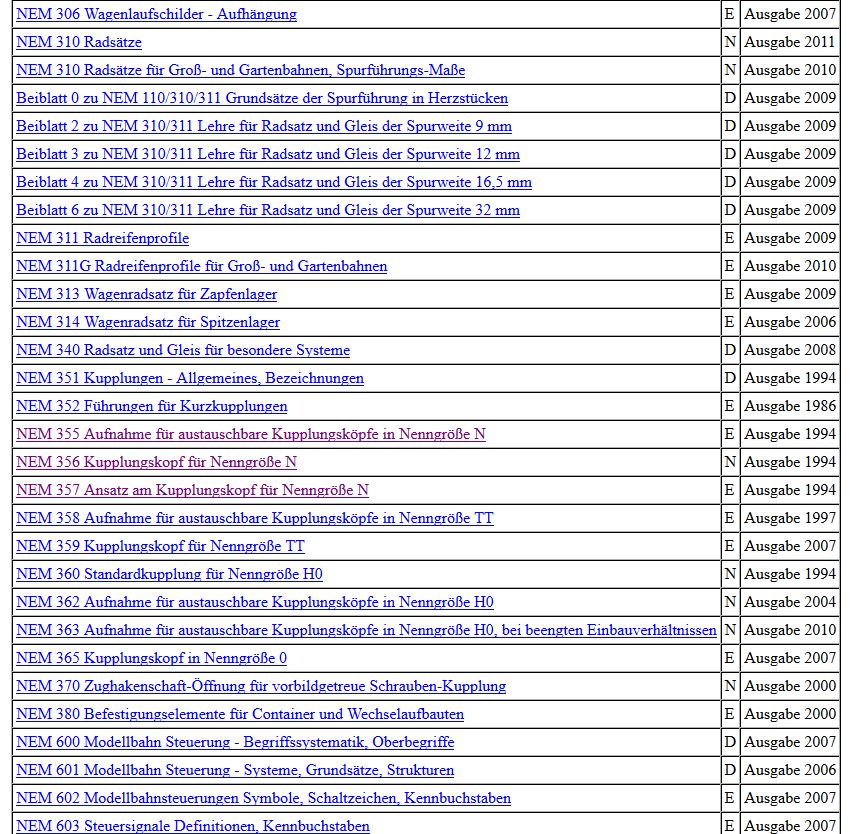
For further information, here is a link to the MOROP/MIBA list of NEM standards: http://www.miba.de/morop/index.htm

